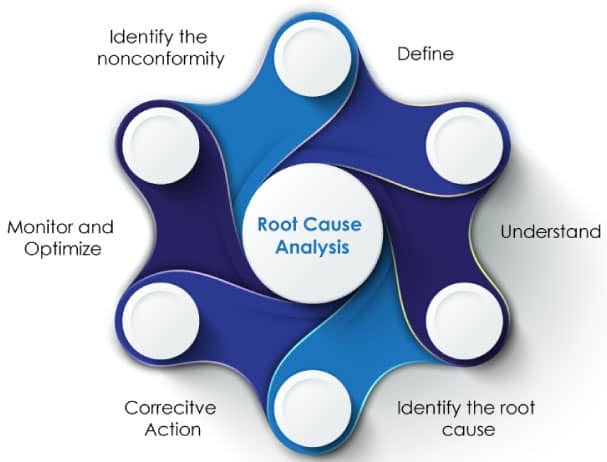
Root Cause Analysis (RCA) is a method that is used to address a problem or non-conformance in the quality process to get to the “root cause” (actual cause of origin) of the non-conformity. RCA helps to correct or eliminate the cause and prevent the problem from recurring (preventive action). Root cause analyses is aimed at improving products or processes quality and must an in systematic ways to be effective.
Different Methods of doing Root Cause Analysis:

Root Cause Analysis Methodology
- Fish bone technique
- The “5” Why’s technique.
- Barrier Analysis
- Change Analysis
- Casual Factor tree analysis
- Failure mode and effects analysis
- Pareto analysis
Advantages
- Identifies Underlying Issues: Root cause analysis helps uncover the underlying factors contributing to problems or incidents, rather than just addressing symptoms. By identifying the root cause, organizations can implement effective solutions that prevent recurrence.
- Prevents Recurrence: By addressing the root cause of issues, organizations can implement corrective actions to prevent similar problems from occurring in the future. This helps improve operational efficiency and reduces the risk of costly rework or downtime.
- Improves Risk Management: Root cause analysis helps identify potential risks and vulnerabilities within processes or systems. By addressing root causes, organizations can proactively mitigate risks and prevent potential incidents or failures.
- Promotes Continuous Improvement: Root cause analysis is an essential tool for driving continuous improvement initiatives. By systematically identifying and addressing root causes, organizations can refine processes, enhance product quality, and increase customer satisfaction over time.
Challenges
- Not having the ability to understand the problem and therefore not defining it correctly.
- Not considering all possible failure modes.
- Not able to identify all root causes.
- No properly defined solution for the non-conformity.
The “5” Why technique causes mapping

Non-conformity identified: Decrease in the viscosity of Vitamin D3 syrup. The “5” why technique can be expanded to 15 why or 150 why the deeper you go the more thorough analyzing takes place and reveals better solutions.
Contact us for more information about the AmpleLogic Quality Systems Offerings.



























